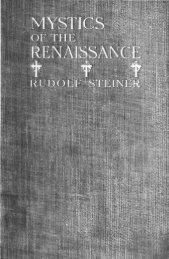The Supreme Doctrine - neo-alchemist
The Supreme Doctrine - neo-alchemist
The Supreme Doctrine - neo-alchemist
Create successful ePaper yourself
Turn your PDF publications into a flip-book with our unique Google optimized e-Paper software.
THE FIVE MODES OF THOUGHT<br />
<strong>The</strong> thought of waking-with-reveries is intermediary between the<br />
dream thought and the thought of man adapted to the real external present. It<br />
can be very near the dream thought, with the same apparent absurdity. It can<br />
also be constructed no longer in the symbolical style but in the realistic style<br />
such as we shall see in the fourth mode.<br />
<strong>The</strong> realistic thought of man adapted to the real external present is<br />
composed of images which are no longer content to suggest meaning without<br />
containing it within themselves. <strong>The</strong>se are concrete images which claim to<br />
have a real immediate meaning that is adequate for the concrete reality. <strong>The</strong><br />
meaning of this thought lies less behind its expression than within it. We do<br />
not say, however, that the meaning of the thought does not lie at all behind its<br />
expression; indeed the meaning, which is the relative truth of the thought, is a<br />
manifestation of inexpressible primordial Truth; and this thought would be<br />
meaningless, would not even exist, if it had no meaning behind its form; it is<br />
by virtue of this latent meaning that the form contains a certain manifest and<br />
relative meaning.<br />
Pure intellectual thought, in the man who reflects, who meditates, is no<br />
longer constructed in the realistic style but in the pure intellectual style. Its<br />
images are abstract and, in contrast to what applied to realistic thought,<br />
correspond with nothing that the sense-organs can perceive. <strong>The</strong> Hindus<br />
regard the mind as the sixth organ of sense; this view is very defensible, in<br />
the sense that the mind, like the sense-organs, transmits nothing that is not<br />
relative; but the mind differs in another respect from the sense-organs in that<br />
it alone transmits perceptions that are abstract and general. In this mode of<br />
thought the images pretend to much more than in realistic thought. Rejecting,<br />
categorically this time, the modest role of indirectly suggesting the truth, they<br />
claim to contain in themselves a meaning of general import. Formal<br />
expression is at its apogee, the substance behind the form is at its minimum.<br />
Considering these five modes of thought spread out serially, we<br />
necessarily ask ourselves what hierarchy there is among them. Current<br />
opinion sees in the succession from the first mode to the fifth a progression;<br />
it rates the state of the man who deals with external reality above the state of<br />
the man who sleeps, and it rates the state of the man who meditates on<br />
general laws above the state of the man who deals with concrete reality.<br />
This opinion is partially correct. But we will see first wherein it is<br />
wrong, wherein the Vedânta is right in regarding the state of deep sleep as<br />
superior to the state of sleep-with-dreams, and this as superior to the waking<br />
57




